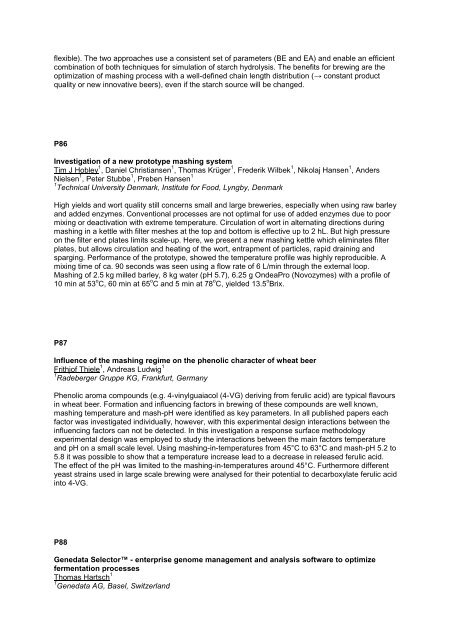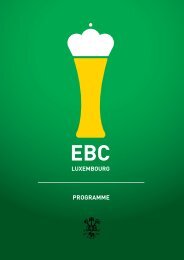here - the 34th European Brewery Convention
here - the 34th European Brewery Convention
here - the 34th European Brewery Convention
Create successful ePaper yourself
Turn your PDF publications into a flip-book with our unique Google optimized e-Paper software.
flexible). The two approaches use a consistent set of parameters (BE and EA) and enable an efficient<br />
combination of both techniques for simulation of starch hydrolysis. The benefits for brewing are <strong>the</strong><br />
optimization of mashing process with a well-defined chain length distribution (→ constant product<br />
quality or new innovative beers), even if <strong>the</strong> starch source will be changed.<br />
P86<br />
Investigation of a new prototype mashing system<br />
Tim J Hobley 1 , Daniel Christiansen 1 , Thomas Krüger 1 , Frederik Wilbek 1 , Nikolaj Hansen 1 , Anders<br />
Nielsen 1 , Peter Stubbe 1 , Preben Hansen 1<br />
1 Technical University Denmark, Institute for Food, Lyngby, Denmark<br />
High yields and wort quality still concerns small and large breweries, especially when using raw barley<br />
and added enzymes. <strong>Convention</strong>al processes are not optimal for use of added enzymes due to poor<br />
mixing or deactivation with extreme temperature. Circulation of wort in alternating directions during<br />
mashing in a kettle with filter meshes at <strong>the</strong> top and bottom is effective up to 2 hL. But high pressure<br />
on <strong>the</strong> filter end plates limits scale-up. Here, we present a new mashing kettle which eliminates filter<br />
plates, but allows circulation and heating of <strong>the</strong> wort, entrapment of particles, rapid draining and<br />
sparging. Performance of <strong>the</strong> prototype, showed <strong>the</strong> temperature profile was highly reproducible. A<br />
mixing time of ca. 90 seconds was seen using a flow rate of 6 L/min through <strong>the</strong> external loop.<br />
Mashing of 2.5 kg milled barley, 8 kg water (pH 5.7), 6.25 g OndeaPro (Novozymes) with a profile of<br />
10 min at 53 o C, 60 min at 65 o C and 5 min at 78 o C, yielded 13.5 o Brix.<br />
P87<br />
Influence of <strong>the</strong> mashing regime on <strong>the</strong> phenolic character of wheat beer<br />
Frithjof Thiele 1 , Andreas Ludwig 1<br />
1 Radeberger Gruppe KG, Frankfurt, Germany<br />
Phenolic aroma compounds (e.g. 4-vinylguaiacol (4-VG) deriving from ferulic acid) are typical flavours<br />
in wheat beer. Formation and influencing factors in brewing of <strong>the</strong>se compounds are well known,<br />
mashing temperature and mash-pH were identified as key parameters. In all published papers each<br />
factor was investigated individually, however, with this experimental design interactions between <strong>the</strong><br />
influencing factors can not be detected. In this investigation a response surface methodology<br />
experimental design was employed to study <strong>the</strong> interactions between <strong>the</strong> main factors temperature<br />
and pH on a small scale level. Using mashing-in-temperatures from 45°C to 63°C and mash-pH 5.2 to<br />
5.8 it was possible to show that a temperature increase lead to a decrease in released ferulic acid.<br />
The effect of <strong>the</strong> pH was limited to <strong>the</strong> mashing-in-temperatures around 45°C. Fur<strong>the</strong>rmore different<br />
yeast strains used in large scale brewing were analysed for <strong>the</strong>ir potential to decarboxylate ferulic acid<br />
into 4-VG.<br />
P88<br />
Genedata Selector - enterprise genome management and analysis software to optimize<br />
fermentation processes<br />
Thomas Hartsch 1<br />
1 Genedata AG, Basel, Switzerland





